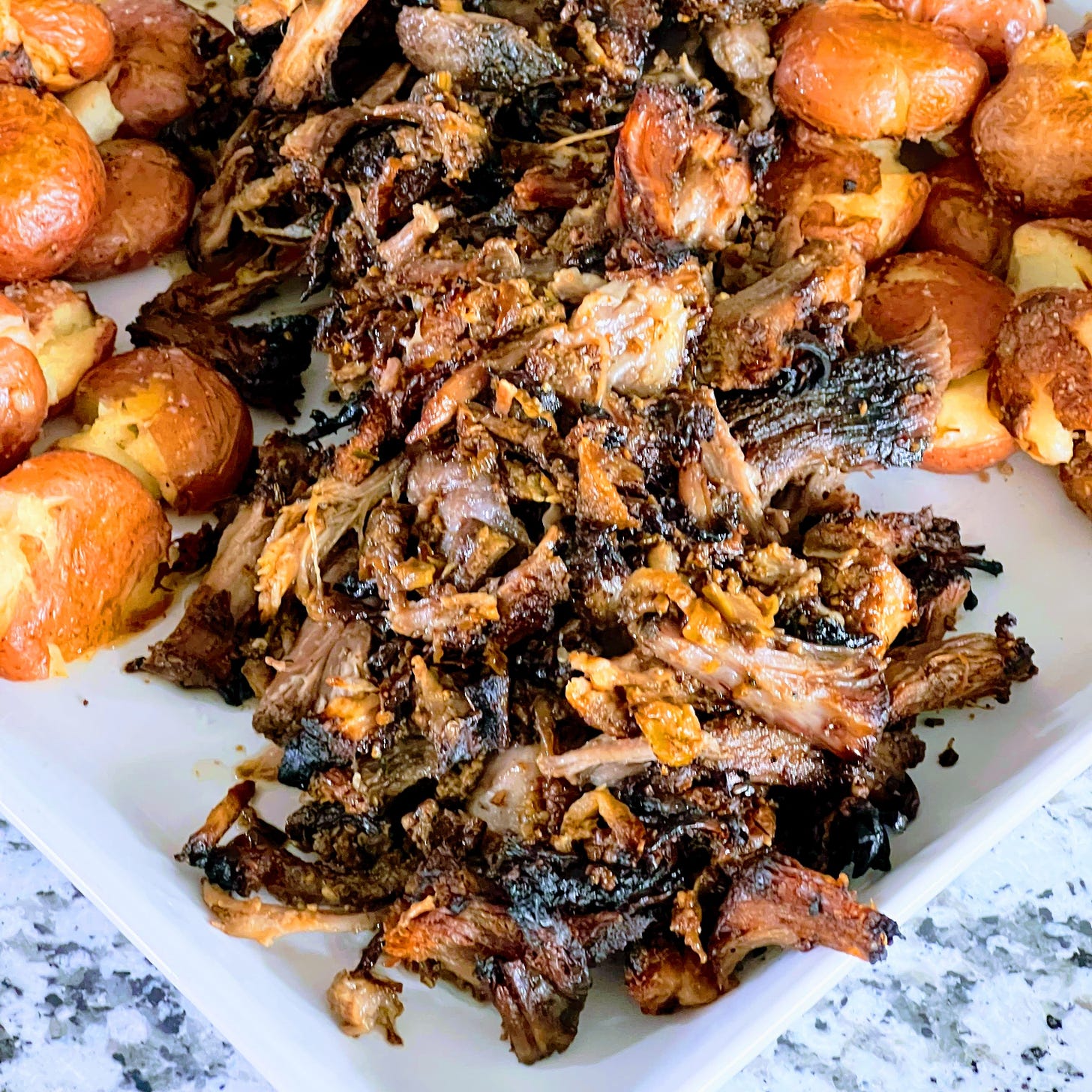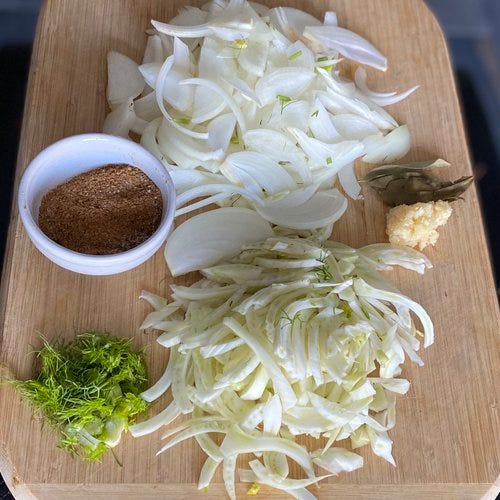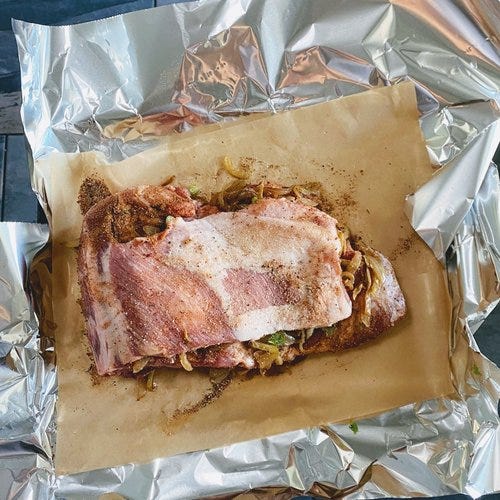A decade ago a friend of mine in Napa Valley served me a pork shoulder from a Michael Chiarello cookbook she had on hand. It had flavor like I had never encountered before. Over the years, I have recreated it adding my own flair since I don't have the cookbook. I "humbly" present to you the Most Flavorful Slow Roasted Pork Shoulder you will ever make. ;)
What Makes This Slow Roasted Pork Shoulder So Flavorful
The original recipe was really good. What I didn't love is it used spices I didn't keep regularly like white peppercorns and coriander seeds. I generally don't love coriander even though I love cilantro (aka coriander in many countries). It also wasn't spicy enough for me and I found myself wanting to add something. When I added some red pepper flakes the first time, it was a gamechanger. Doubling down on the fennel flavor by using thinly sliced fennel bulb along with the onions added complexity. After slow roasting, the fennel and onions got slightly crispy adding a sweet and somehow slightly acidic flavor that perfectly offset the fat of the pork.
Pork Shoulder Vs Pork Butt
There is some confusion over what a pork shoulder is. Sometimes the term is used interchangeably with pork butt, however they are different. Ironically, the pork shoulder is from the leg of the pig and the pork butt is from the shoulder of the pig making it even more confusing.
Both are large cuts of meat with lots of marbling that needs to be broken down with slow roasting. Many times, the two cuts can be used for slow roasting but for this recipe you want to make sure there is a fairly large fat cap. The pork shoulder tends to be better for this since spices and the sauteed veggies will be "stored" underneath.
How to Make Slow Roasted Pork Shoulder
This is mostly hands-off recipe. After rubbing the pork with a spice rub and sautéing fennel and onions, you will simply assemble the roast then place in a low oven for 8+ hours. Par-cooked potatoes can be added after the initial cooking time so they can absorb flavors.
Vegetables and Spices
Saute Vegetables
Nice and Golden Brown
Pork is Spice Rubbed and Topped with Veggies
Replace Fat Cap and Season Well
Roast Until Brown and Crispy
What is Fennel?
Fennel is both a vegetable and a spice. The spice is very familiar if you like Italian sausage. It is a very prominent flavor in traditionally made Italian sausage and really what makes the sausage "Italian". It's a small striped seed that tastes amazing when slightly toasted. It has a licorice flavor which at first may be a turnoff if you only think of the black licorice candy, but it is actually very mild. Think about basil and you will be on the right track. (Basil also has a slightly licorice flavor.)
The vegetable form is a bulb with a crunchy texture similar to celery without the strings. It also has a very slight licorice flavor (less so than the seed) that is truly refreshing raw but cooks down to a very sweet and savory flavor.
Make Ahead Slow Roasted Pork Shoulder
While you can certainly make this any time day, you will want to plan ahead as it roasts for 6-8 hours. It is largely hands off so I generally either start it early in the day or better yet, I roast it overnight, let it sit and cool, refrigerate and then serve later that day or the next. If you do this, add the potatoes when you reheat it. Pre-cooking also allows you to remove the excess fat layer that will harden as it cools. See notes in the recipe below for full instructions.
What to Serve with Slow Roasted Pork Shoulder
The pork shoulder is super flavorful and very fatty so having something to absorb the flavors and cut the fat is crucial. I love serving it with smashed potatoes cooked in the pork fat and a big mixed green salad with my Lemon Vinaigrette.
Slow Roasted Pork Shoulder with Potatoes
3 lb pork shoulder
3 tbsp fennel seeds
2 tbsp Magic Salt
1 tbsp red pepper flakes (optional)
Extra Virgin olive oil
1 large fennel bulb with some fennel fronds, thinly sliced
1 large yellow onion, thinly sliced
3 cloves garlic thinly sliced
2-3 lbs small red or Yukon Gold potatoes
Instructions
Cover a rimmed baking sheet with foil. Heat oven to 275 degrees.
Using a very sharp carving or chef's knife, cut along the fat cap following the contour of the meat of the pork shoulder from one side to the other without cutting through to make a large flap. Transfer the pork shoulder to the foil covered cookie sheet.
Toast the fennel seeds in a small skillet until they are fragrant. Grind them in a spice or coffee grinder or in a mortar and pestle.
Blend the fennel seeds with magic salt and red pepper flakes. Sprinkle all sides of the pork shoulder, especially under the fat cap with the spice mixture.
Heat the olive oil in a large skillet over medium heat for a minute or two. Add the fennel, onions and garlic and saute under softened and starting to turn golden.
Spread this mixture under the fat cap evenly. Replace the fat cap and place the baking sheet into the oven.
Roast for 6-8 hours until the pork falls apart when pulled with a fork.
Meanwhile, parcook the potatoes. Bring a large pot of salted water to a boil. Add the potatoes and let boil until a paring knife can be easily inserted and removed. When cool enough to handle, gently press each potato to flatten them slightly without completely crushing them.
When pork is done, increase the heat to 450 and add the flattened potatoes basting them with the pan juices. Let the potatoes cook until they are golden brown and crispy on the edges. if the pork begins to get too dark on top, remove it to a cutting board with a well around the edges to collect any juices. (It's ok if it gets crispy and a little darker brown, you just don't want to burn it.)
To serve, remove the fat cap and discard. Cut or pull the pork apart into large 2-3" pieces removing any pieces of fat or cartilage. Serve the pork and potatoes with the pan juices.
Make Ahead Instructions
If you choose to make the slow roasted pork shoulder ahead, allow it to cool slightly then remove the fat cap and break down into serving sized pieces. Cool completely before refrigerating and do not cook the potatoes until you plan to serve them. Once the pork and juices have been refrigerated, you can remove the fat layer that will harden on top to give you less fatty pan juices. When you are ready to serve, allow the pork to come to room temperature (about an hour) then cook on 350 for 45 minutes or until steaming then increase oven temp to 450 degrees. Add the parcooked potatoes (step 8) and cook as directed above.
©2024 Christi Flaherty, Flaherty Culinary Concepts and realfoodsanity.com. All Rights Reserved. No part may be reproduced, used to create a derivative work, or transmitted in any form or by any means without the written consent of the author.
Did you make this recipe?
Tag @realfoodsanity on instagram and hashtag it #realfoodsanity












